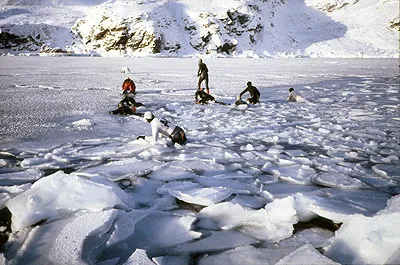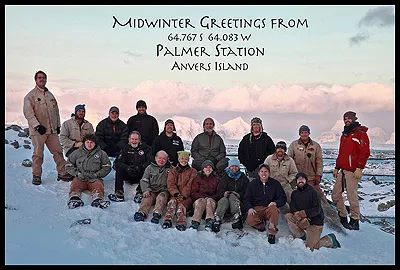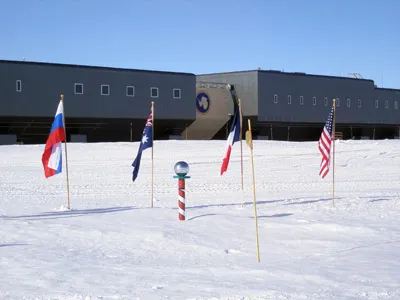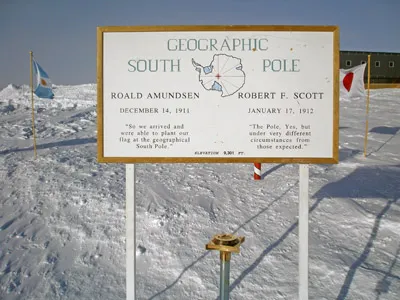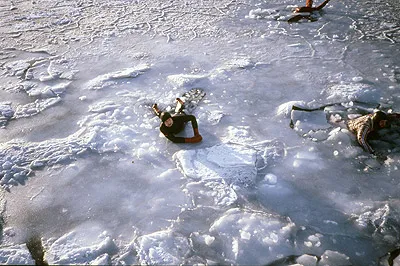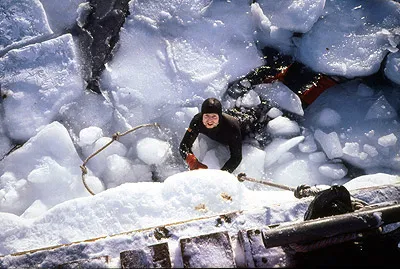Antarctic Celebrations and Traditions
Culture, traditions and customs from Antarctica.
People have only inhabited Antarctica in any way for a little over a hundred years, the first overwintering party being in 1898.
Slowly at first, wintering parties at temporary bases became more common, staying for a year or two, and then bases were used more permanently. The first permanent station was established early on by Bruce on the Scotia Expedition on Laurie Island in the South Orkneys in 1903, when his work was done done there after two years it was given to the government of Argentina, the station has been continually manned ever since. The International Polar Year of 1932 / 1933 and International Geophysical Year of 1958 / 1959 led to more scientific activity in Antarctica and especially in 1958-59 to the establishment of a number of permanently manned stations many of which are still used today.
The Antarctic community is very recent compared to anywhere else in the world and consists entirely of visitors, whether they are scientists and support workers on nationally run stations or tourists. The staff on scientific stations stay for anywhere from a few weeks to a little over two years, tourists stay for about 5 - 30 days. Scientific stations are often hundreds of miles apart, they are almost all run on national lines by the countries that establish them.
The result of this is that any celebrations, festivals, traditions or customs in Antarctica are relatively recent and tend to be specific to a particular country's bases rather than being very widespread.
The biggest (and only) exception to this is Midwinter on the 21st of June which is celebrated right across Antarctica by all nations and stations. More about Midwinter in Antarctica here. Second to Midwinter in celebration terms is Christmas in Antarctica. These have their own traditions and rituals.
300 Club at the South Pole
The 300 stands for a change in temperature of that many degrees Fahrenheit, the equivalent in Celsius is 167.
The idea is to wait until the temperature outside reaches an exceptionally low temperature and go into a sauna where you reach the higher temperature. You then open the door and run around some designated marker wearing only boots so achieving a difference of 300F before re-entering the building to warm up again. Fortunately extremely low temperatures tend to occur during still and windless weather, even the slightest breeze can make things a lot worse in such conditions.
The sauna reaches a temperature of about +93C / +200F. A 300 difference requires serious cold of -100F / -73C too, such as experienced at the South Pole Station. Due to the extreme lower temperature needed, joining the 300 club can only happen on a limited number of days in the deep winter months. At the South Pole, the marker to run round is (obviously) the geographic South Pole through all time zones, with the trek from sauna to pole and back to the building taking a few minutes. Running is not advised as it causes heavier breathing which can hurt your air passages leading to a couple of days coughing while your body fixes the damage.
One hand over the mouth and the other holding onto the gentleman's region or ladies protuberances as appropriate is advised as such regions are prone to getting very cold indeed and bragging about frostbite there is really a rugged step too far for most people.
The practice arose in the 1950's when people first wintered at the South Pole, though early "hot boxes" didn't really get hot enough, later on stations had saunas installed which allowed for a sufficient temperature difference. In the early days a roll in the snow would sometimes be added too, just because it could.
Unsurprisingly the 300 club is one of the most exclusive in the world, not many can say they went from a sauna at +200F to -100F almost instantly in the nude, and ran round the world before coming back again.
It can get a bit boring in the Antarctic winter.
Polar Plunge
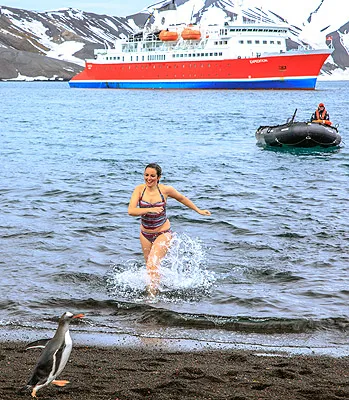
Almost certainly the most widespread "custom" in Antarctica, and like most on this page, it revolves around being scarily cold, but only briefly. The seas around Antarctica vary from about -2C to +2C throughout the year, at -2C the sea freezes, the salt content makes this happen below 0C, so Antarctic sea water is often as cold as it is possible for water to get, especially in the winter months.
Jumping in the sea wearing swimming attire (or just naked if you don't have any and aren't going to traumatise those around you) is a surprisingly popular thing to do. Originally something that was done by members of scientific bases particularly at Midwinter or Christmas, this has spread across the continent and now happens far more often as shorter term visitors in the summer want to have a go too.
The usual procedure is to jump into the sea tied to a rope, in the winter this may require a hole to be cut through the sea ice to access the sea first, there may be a ladder to help you get out at the other side, in open water the plunge may include a short swim to a nearby boat.
Many tourist ships visit Deception Island in the Peninsula region where there are (small) areas where the water is warmed by geothermal heat, in this case as in the associated picture, the procedure is to run into the water, dip under and run out again. Extra points if you get a penguin in the picture too,
This takes place at many bases such as McMurdo, Palmer (US) Scott (NZ) Mawson, Davis (AUS) and others and has now even spread to tourists on cruise ships in the summer months.
The idea is not unique to Antarctica, in recent years doing similar things in frozen lakes and seas, or unfrozen lakes and seas in cold places in winter has become a way to raise money for charity. There are many accounts online if you are inclined to look for them, even some that speak of it as a heroic go-getting, entrepreneurial, risk-taking, noble endeavour that allows you to demonstrate your no-nonsense, carpe-diem approach to life. It's just a bit of fun really in a "You'll never guess what I did!" way.
Signy Thin Ice Race
The British Base at Signy Island in the South Orkneys is surrounded by open sea in the summer and continuous sea ice for much of the winter. The base used to be a main center for marine biology and had a diving center, most if not all base members whatever their job would dive recreationally and there were enough wet suits for all the winter base compliment.
At the start of the winter as the temperature fell and the sea began to freeze in the cove in front of the base, the base commander would inspect the ice and declare it ready for the "Thin Ice Race". This would happen the same day as the state of the ice was critical, it should be almost thick enough to sustain being walked on, but not reliably so, so you'd rather not. If it was left overnight it would probably be too thick.
Everyone would then go and get kitted up in their wet suit and possibly associated fancy dress and assemble at the start point. On the word go everyone would rush off across the ice and start to fall through it into the sea. The course was 300-400m long, it favoured light runners with big feet, but slower runners could jump on the ice next to the leaders sending both into the icy sea, so it took a long time to finish the course. It sounds like the coldest thing you can imagine, but overheating was a problem and breaks while floating in a sea-water pool you had made were most welcome!
48 hour Antarctic Film Festival
Running since 2006, this is an annual festival where each base in Antarctica is invited to submit a film of no more than 5 minutes duration that must contain 5 elements that are suggested by 5 different bases at the start of the festival to ensure that the films really are made in the 48 hour window and not prepared in advance. It takes place over a weekend in early August, so more than a month after Midwinter and can only involve the winterers as summer is still a long way off. There is also another (less popular) open category for a 5 minute film with no restrictions.
For instance:
- The sound of ice cracking
- A map of the station
- A computer mouse
- A queen
- The line "I'll save you"
- The sound of a squealing pig
- A swing
- A Swim Suit
- Wal Footrot, an iconic Kiwi cartoon character and Google able
- The line "It'll be dark soon and they mostly come at night, mostly."
The completed films are uploaded to the internet and winners decided by popular vote. They have a tendency towards the odd or downright strange, but they look like they have a lot of fun making them!
There are lots more on youtube if you want to take a look,
A couple of examples:
-
Where the Wild Things Are: 2018 Antarctic Winter Film
Festival
- Davis Station - 2020 Winter International Film Festival of Antarctica - Totally Cooked
Polar plunge picture credit - Murray Foubister, used under CC2 Attribution Share Alike Generic licence.

